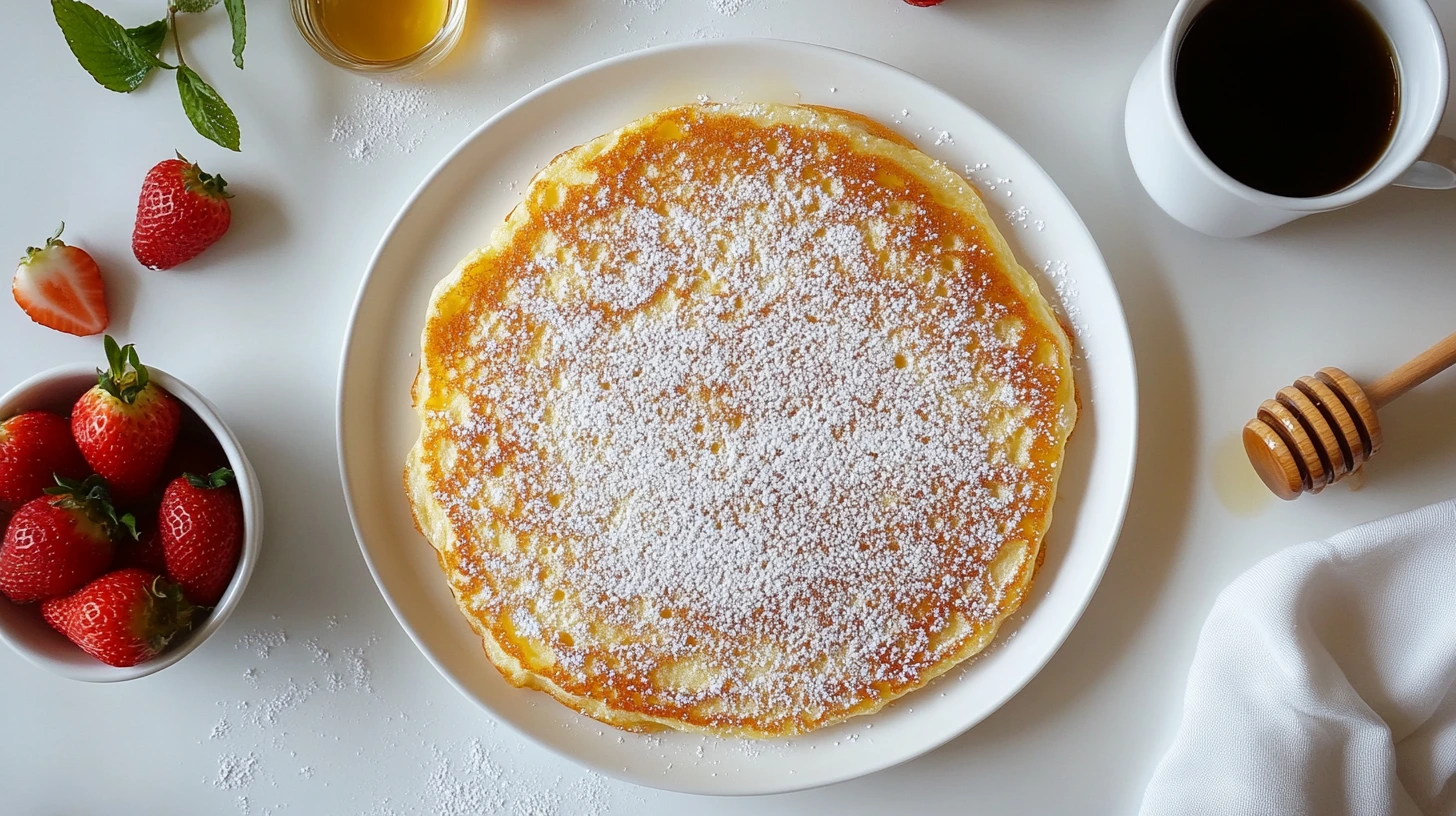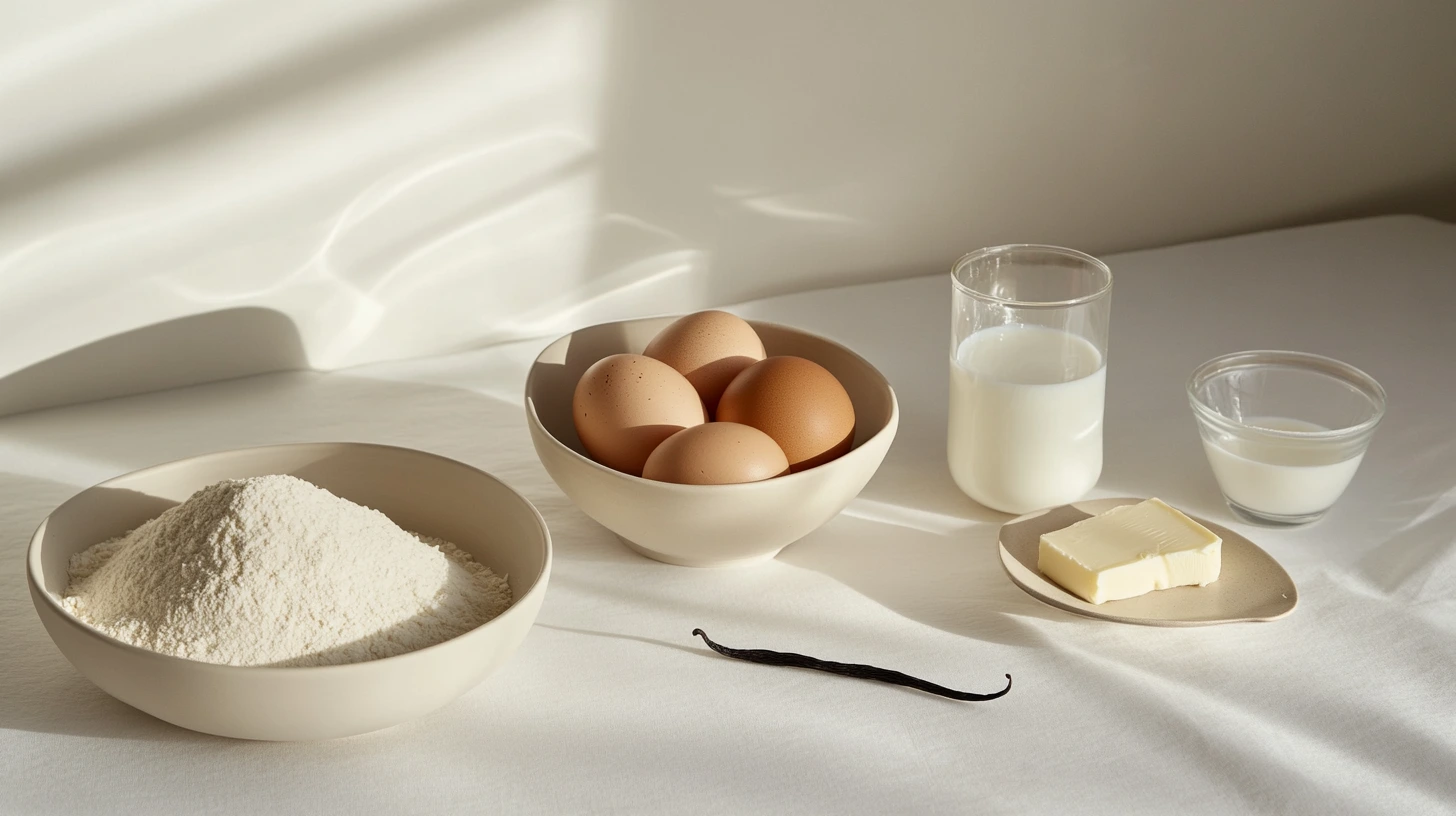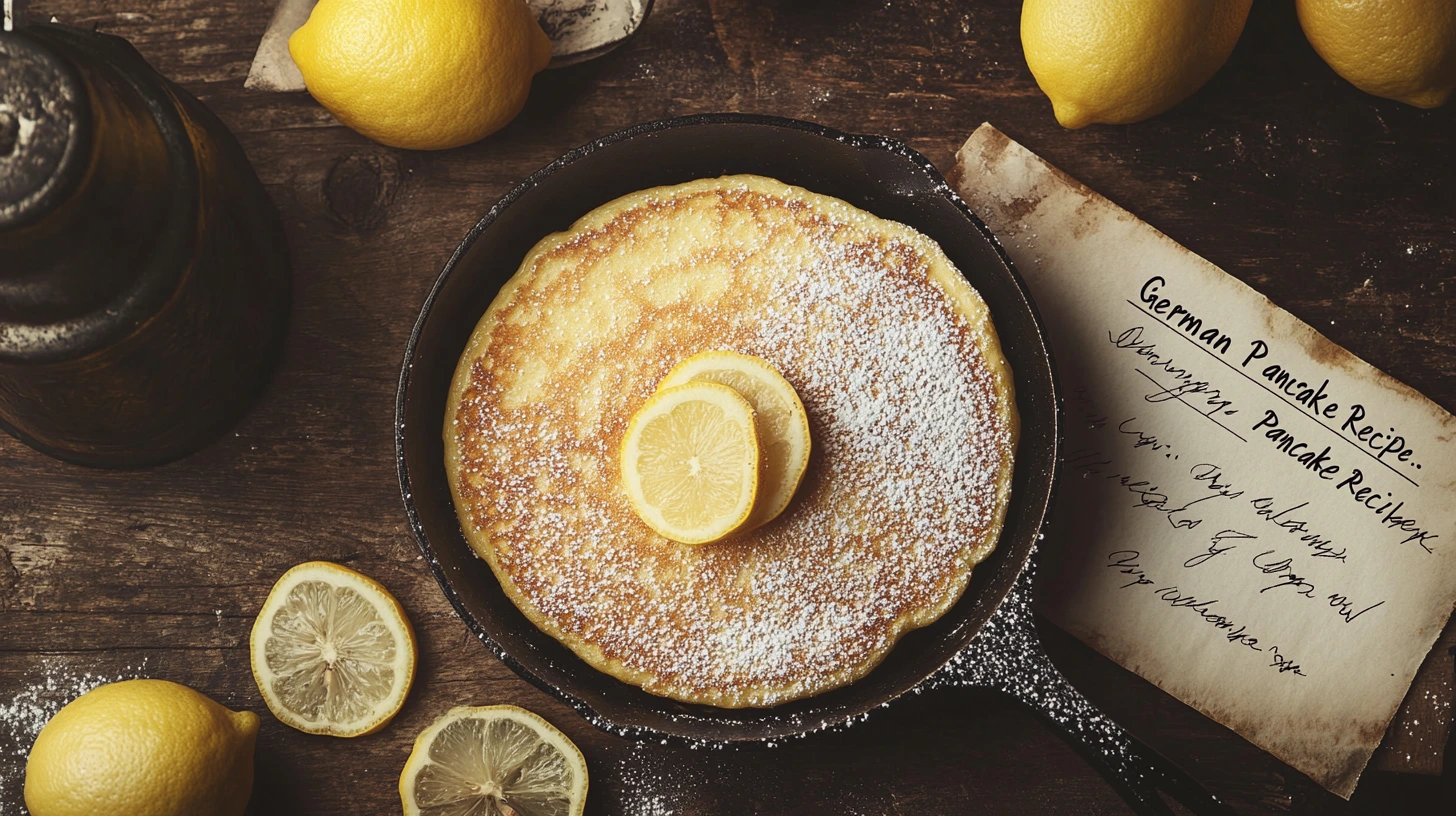
Table of Contents
Introduction to German Pancake Recipe
What Are German Pancakes?
German pancakes, or Dutch babies, are light and fluffy oven-baked pancakes made with a simple batter of eggs, milk, flour, and butter. Unlike traditional stovetop pancakes, German pancakes are cooked in a preheated skillet or baking dish in the oven, puffing up dramatically, creating crispy edges and a custard-like center. They are often topped with powdered sugar, fresh fruits, or syrup, making them a versatile and delicious breakfast or brunch dish.
How They Differ from Traditional Pancakes
- Cooking Method:
- German pancakes are baked in the oven rather than on a grill or stovetop. The high oven heat helps the batter rise and creates its signature puffed shape.
- Texture:
- Unlike traditional pancakes, which have a fluffy, cake-like texture, German pancakes have a custardy center and crisp, golden-brown edges.
- Ingredients:
- The batter for German pancakes is thinner and eggier than the standard pancake batter, giving them a more souffle-like quality.
- Presentation:
- While traditional pancakes are typically stacked, German pancakes are served whole, often in the same dish they were baked in, with a dramatic puffed appearance.
Why They’re a Favorite for Breakfast and Brunch
- Easy to Prepare:
- The batter comes together quickly with a blender or whisk, and the oven does all the work—no flipping required!
- Impressive Presentation:
- Their dramatic puffed shape and golden edges make German pancakes a show-stopping centerpiece for any breakfast or brunch table.
- Versatility:
- German pancakes can be topped with various ingredients, from sweet options like powdered sugar, maple syrup, and fruit to savory toppings like cheese, herbs, and smoked salmon.
- Crowd-Pleasing Flavor:
- Their light, airy texture and slightly sweet, eggy flavor make them universally appealing. They are perfect for casual family mornings and special occasions.
Step-by-Step Recipe for German Pancake Recipe

Mixing the Batter
- Gather Ingredients:
- Three large eggs
- ½ cup (120 ml) milk (whole milk is best)
- ½ cup (60 g) all-purpose flour
- One tablespoon sugar (optional for sweetness)
- ½ teaspoon salt
- One teaspoon of vanilla extract (optional)
- Blend or Whisk:
- Combine the eggs, milk, flour, sugar, salt, and vanilla extract in a blender. Blend until smooth, about 20–30 seconds.
- Alternatively, whisk the ingredients together until the batter is free of lumps.
- Tip: Let the batter rest for 5–10 minutes to allow the flour to hydrate, creating a smoother texture.
Preparing the Pan
- Choose the Right Pan:
- Use a 10–12-inch oven-safe skillet, such as a cast iron or stainless steel pan, or a glass baking dish.
- A heavy-bottomed pan ensures even heat distribution for a well-puffed pancake.
- Preheat the Pan:
- Preheat the pan in the oven to 425°F (220°C). Preheating the pan ensures the pancake puffs evenly and develops crisp edges.
- Add Butter:
- Once the oven is preheated, carefully remove the hot pan and add two tablespoons of unsalted butter. Swirl the butter to coat the pan’s surface evenly.
- Pour the prepared batter into the hot, buttery pan immediately.
Baking to Perfection
- Bake:
- Place the pan back in the oven and bake for 18–22 minutes.
- The pancake is done when it has puffed dramatically, with golden-brown edges and a slightly set, custardy center.
- Don’t Open the Oven Door:
- Resist the temptation to open the oven while baking, as sudden temperature changes can cause the pancake to deflate prematurely.
- Finishing Touch:
- Remove the pancake from the oven and serve immediately. The pancake will deflate slightly as it cools, which is normal.
Serving Suggestions
- Sweet Toppings: Sprinkle with powdered sugar, drizzle with maple syrup, or serve fresh fruit, jam, or whipped cream.
- Savory Options: Add a dollop of sour cream, smoked salmon, or sautéed vegetables.
Serving Suggestions for German Pancake Recipe
Classic Toppings
- Powdered Sugar:
- Lightly dusting powdered sugar is a traditional and elegant way to serve German pancakes. It adds sweetness and highlights the pancake’s golden-brown color.
- Maple Syrup:
- Warm maple syrup enhances the buttery flavor of the pancake and complements its light, custardy texture.
- Lemon Juice and Sugar:
- A squeeze of fresh lemon juice paired with a sprinkle of granulated sugar provides a tangy, sweet contrast, offering a refreshing and classic European-style topping.
Seasonal Fruit Pairings
- Spring:
- Fresh strawberries, raspberries, or blueberries. Add a dollop of whipped cream for an extra indulgent touch.
- Summer:
- Slices of ripe peaches, nectarines, or mango. A drizzle of honey pairs beautifully with these fruits.
- Fall:
- Caramelized apples or pears, spiced with cinnamon and nutmeg. Top with a few toasted pecans for crunch.
- Winter:
- Citrus segments, such as orange or grapefruit, sprinkled with a bit of brown sugar for a bright, zesty topping.
Creative Twists
- Whipped Cream:
- Add a generous dollop of lightly sweetened whipped cream. For added flavor, enhance with a touch of vanilla or almond extract.
- Nuts and Seeds:
- Sprinkle toasted almonds, pecans, or hazelnuts over the pancake for crunch and a nutty flavor. For a savory twist, try sesame seeds or sunflower seeds.
- Chocolate Drizzle:
- Melt dark, milk, or white chocolate and drizzle it over the pancake for a decadent dessert-like experience. For a stunning presentation, combine with a sprinkle of powdered sugar or fresh berries.
- Yogurt and Granola:
- Spread a thin layer of Greek yogurt on top and sprinkle with granola and honey for a wholesome and satisfying breakfast option.
- Savory Options:
- Add toppings like smoked salmon, cream cheese, sautéed mushrooms, and spinach for a savory brunch twist.
Presentation Tips
- Serve the pancake straight from the skillet or baking dish to retain its rustic, dramatic, puffed shape.
- For an elevated touch, garnish with fresh mint leaves, edible flowers, or a light dusting of cocoa powder.
Variations on the Classic German Pancake Recipe
Savory German Pancake Recipe with Cheese and Herbs
- Cheese Options:
- Shredded cheeses like Gruyère, Parmesan, cheddar, or feta can be incorporated into the batter or sprinkled on top before baking for a savory twist.
- Herbs and Seasonings:
- Mix chopped fresh herbs like parsley, chives, or thyme into the batter for added flavor.
- Add a pinch of garlic powder, onion powder, or smoked paprika to enhance the savory profile.
- Toppings:
- Serve with sautéed vegetables, crispy bacon, smoked salmon, or a dollop of sour cream for a hearty and satisfying meal.
- Serving Ideas:
- Pair with a side salad for a light lunch or serve as a savory brunch dish.
Gluten-Free and Dairy-Free Adaptations
- Gluten-Free Options:
- Replace all-purpose flour with a gluten-free blend that includes xanthan gum for structure.
- Alternatively, use almond or oat flour for a nutty or wholesome flavor.
- Ensure the batter consistency is slightly thin but smooth for proper puffing.
- Dairy-Free Substitutes:
- Replace whole milk with almond, oat, or coconut milk for a dairy-free version.
- Use a dairy-free butter substitute or coconut oil to grease the pan.
- Tips:
- Rest gluten-free batters for 5–10 minutes before baking to allow the flours to hydrate for a smoother texture.
- Be mindful of the temperature and baking time, as gluten-free batters may cook differently.
Adding Spices Like Cinnamon or Nutmeg
- Warm Spices:
- Add ½ teaspoon cinnamon or ¼ teaspoon nutmeg to the batter for a cozy, aromatic twist.
- Combine these spices with a vanilla extract to enhance the pancake’s sweetness.
- Holiday-Inspired Variations:
- Add a pinch of allspice or cloves for a festive flavor, perfect for fall or winter gatherings.
- Pairing with Toppings:
- These spiced pancakes pair beautifully with toppings like maple syrup, caramelized apples, or a drizzle of honey.
Tips for Successful Variations
- Adjust Ingredients Gradually:
- Introduce substitutions or additions in small amounts to maintain the right batter consistency.
- Experiment with Toppings:
- Tailor the pancake’s flavor profile by pairing variations with complementary toppings, whether sweet or savory.
- Bake with Confidence:
- Keep the baking temperature and method consistent to ensure the pancake puffs up and cooks evenly, regardless of the variation.
Storing and Reheating German Pancakes

How to Store Leftovers
- Cool Completely:
- Allow the German pancake to cool to room temperature before storing. This prevents condensation, which can make it soggy.
- Wrap or Cover:
- To keep the leftover pancake fresh, transfer it to an airtight container or wrap it tightly in plastic wrap or aluminum foil.
- Refrigeration:
- Store in the refrigerator for up to 3–4 days. Proper wrapping or sealing will help preserve its flavor and texture.
Best Ways to Reheat Without Losing Texture
- Oven Reheating:
- Preheat your oven to 350°F (175°C).
- Place the pancake on a baking sheet and cover it loosely with aluminum foil to prevent over-browning.
- Heat for 8–10 minutes or until warmed through.
- Pro Tip: The oven method is the best for maintaining crispy edges.
- Stovetop Reheating:
- Heat a nonstick skillet over medium heat and add a small amount of butter or oil.
- Place the pancake in the skillet and heat for 2–3 minutes on each side.
- This method helps revive some of the pancake’s crispy texture.
- Microwave Reheating:
- Place a slice of pancake on a microwave-safe plate and cover with a damp paper towel to prevent drying out.
- Heat in 15–20 second intervals until warmed through.
- Note: While quick, this method may soften the edges.
Freezing for Make-Ahead Convenience
- Freeze Individual Portions:
- Cut the pancake into slices or portions and wrap each piece tightly in plastic wrap. Place the wrapped slices in a freezer-safe zip-top bag or container.
- Label it with the date and freeze it for up to 2 months.
- Reheating from Frozen:
- Oven Method:
- Preheat the oven to 350°F (175°C).
- Place frozen slices on a baking sheet and cover with aluminum foil.
- Bake for 10–12 minutes, or until heated through.
- Microwave Method:
- Remove the wrapping and place a frozen slice on a microwave-safe plate. Cover with a damp paper towel.
- Heat in 30-second intervals, checking for even warming.
- Tips for Freezing Success:
- Avoid adding toppings like powdered sugar or syrup before freezing. Instead, add them fresh after reheating.
- Flash-freeze individual slices on a baking sheet for an hour before wrapping to prevent sticking.
FAQs About German Pancake Recipe
Can I Make German Pancakes Without a Blender?
- Yes, You Can:
- A blender is commonly used for convenience and to achieve a smooth batter, but it’s not essential. You can mix the batter by hand or with a hand mixer.
- By Hand:
- Whisk the eggs thoroughly until frothy, then gradually add the milk, flour, and other ingredients. Whisk vigorously to eliminate lumps.
- Allow the batter to rest for 5–10 minutes to let the flour hydrate for a smoother texture.
- Using a Hand Mixer:
- A hand mixer can achieve a consistency similar to that of a blender. Mix on medium speed until the batter is smooth and lump-free.
What’s the Best Pan Size for German Pancakes?
- Recommended Size:
- Traditional German pancakes are best made in a 10–12-inch oven-safe skillet (such as cast iron) or a 9×13-inch baking dish.
- Why Size Matters:
- The pan size affects the pancake’s thickness and puff. A larger pan yields a thinner, crispier pancake with dramatic edges, while a smaller pan produces a thicker, custardy center.
- Tips:
- Preheat the pan in the oven with butter before adding the batter to ensure even cooking and crispy edges.
- Avoid pans with nonstick coatings unless they are oven-safe to high temperatures.
Can I Use Almond or Oat Milk Instead of Regular Milk?
- Yes, Almond or Oat Milk Works Well:
- Almond and oat milk are excellent dairy-free substitutes for regular milk in German pancakes. Use the same quantity as the recipe calls for.
- Consider the Flavor:
- Almond milk adds a subtle nutty flavor, while oat milk has a slightly sweeter, creamier taste that complements the dish.
- Tips for Success:
- Choose unsweetened, plain varieties to avoid altering the pancake’s flavor profile.
- Shake the almond or oat milk well before use to ensure consistency.
- Other Dairy-Free Options:
- Soy and coconut milk are suitable substitutes, adding a more prosperous tropical flavor.
Final Tips for the Best German Pancakes
Importance of Preheating the Pan
- Ensures a Crispy Texture:
- Preheating the pan in the oven before adding the batter is crucial for achieving the signature crispy edges and golden-brown exterior.
- Prevents Sticking:
- Heating the butter in the hot pan creates a nonstick surface, making it easier to remove the pancake after baking.
- Even Cooking:
- A hot pan helps the batter spread evenly and cook uniformly, resulting in a well-puffed pancake with a tender, custardy center.
- Pro Tip:
- Add the batter to the pan immediately after taking it out of the oven to maintain the high temperature for optimal puffing.
Experimenting with Toppings and Flavors
- Classic Sweet Toppings:
- Powdered sugar, maple syrup, fresh fruit, or a squeeze of lemon juice for a traditional experience.
- Savory Creations:
- For a hearty, savory version, experiment with grated cheese, sautéed vegetables, smoked salmon, or crispy bacon.
- Seasonal Inspirations:
- Incorporate flavors like pumpkin spice or apple-cinnamon compote in fall or fresh berries and mint during spring and summer.
- Custom Flavors:
- Add vanilla, almond extract, or spices like cinnamon and nutmeg to the batter for a personalized touch.
Encouraging Creativity in the Kitchen
- Adapt to Dietary Needs:
- Try gluten-free or dairy-free variations to cater to different dietary preferences while maintaining great flavor and texture.
- Shape and Size:
- Experiment with different pan sizes or muffin tins to create mini German pancakes for individual servings.
- Mix and Match:
- Combine multiple toppings, like whipped cream and a drizzle of chocolate, or create a savory-sweet combo with honey and crispy prosciutto.
- Family Fun:
- Set up a toppings bar so that everyone can customize their pancake with their favorite additions.
- Play with Presentation:
- Serve the pancake directly from the skillet for a rustic look or on a platter with colorful garnishes for an elegant brunch centerpiece.
By preheating your pan, experimenting with flavors and toppings, and embracing creativity, you can transform German pancakes into a versatile and exciting dish perfect for any occasion. Let your imagination run wild, and enjoy the process of making this delightful treat!
Try this recipe tonight and tag us @biscsweet on social media and follow us on Facebook.
